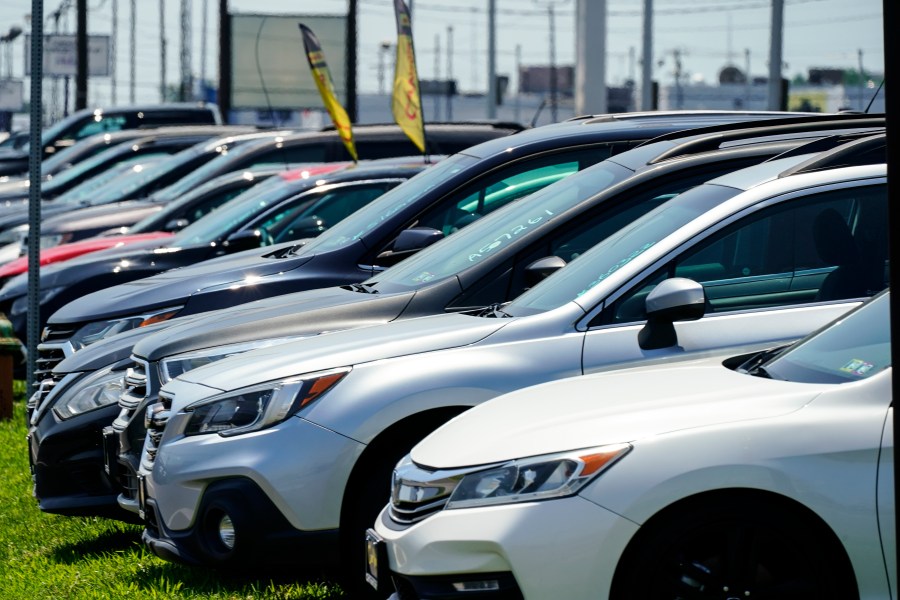Business
‘Remember to shop around’: Owning a car gets more expensive as interest rates soar on August 8, 2023 at 8:47 pm Business News | The Hill

High interest rates and inflation that balloon car payments, maintenance and insurance are keeping the cost of car ownership high, experts said this week.
That means that while the price of used cars is down 11.6 percent from a year ago, according to the new Manheim Used Vehicle Value Index released Monday, the cost of financing a car and keeping it fit for use is rising.
“Used car prices seem to be decreasing at the wholesale level, but not necessarily translating into savings for consumers due to high interest rates and other costs associated with purchasing a vehicle,” Mike Trudeau, executive vice president of business development at Montway Auto Transport, told The Hill.
FILE – A salesman talks with customers in an Acura dealership lot in Wexford, Pa., on Sept. 29, 2022. (AP Photo/Gene J. Puskar, File)
Car prices are steadily dropping
Wholesale used car prices dropped 1.6 percent from June to July, far slower than a 4.2 percent dip the previous month, which marked the largest monthly decrease in used car prices since the start of the pandemic.
Used cars now have the same index value they did in April 2021, just over one year into the pandemic, said Chris Frey, senior manager of economic and industry insights for Cox Automotive, in a statement included in the Manheim Used Vehicle Value Index release.
“While the year-over-year price drop was again double-digit, let’s put some perspective on that. From July 2020, there were 22 straight monthly double-digit increases through April 2022; we’ve had just six double-digit declines since October last year, with only four of them consecutive,” Frey explained.
Frey said he did not foresee wholesale used car price reductions “of serious import” through the end of the year.
New car prices also remain high, but they’ve stabilized from their meteoric price rise after the pandemic restricted vehicle production, lowering supply amid increased demand.
The average buyer paid $48,808 for a new car in June, according to an analysis by Kelley Blue Book. That’s a 1.6 percent increase year-over-year, the smallest since the pandemic began.
Trudeau also anticipated the price of new cars may fall later this year or next.
More Americans looking to buy despite costs rising
With sticker shock slowing, some American car buyers are looking to buy again.
Used car sales were up 6 percent from June to July, Manheim found, and more Americans said they planned to purchase a car within the next six months than at any point over the past nine months.
But an auto loan payment may be significantly higher now, when the Federal Reserve has set interest rates at a 22-year high, than when rates were near zero at the beginning of 2022.
“If you were to finance a $20,000 used car with a loan term of 60 months, even a small increase in the interest rate could result in paying hundreds or even thousands more over the life of the loan,” Trudeau explained.
The Fed is weighing additional interest rate hikes at the September meeting as it works to bring inflation down to its 2 percent target. From credit card debt to mortgages, high interest could make it more expensive to borrow money.
Americans have weathered historic inflation for more than two years, and consumers’ car costs were not spared. While inflation cooled to 3 percent annually in June, down from its 9.1 percent peak the previous summer, motor vehicle maintenance prices remained elevated.
Car repair costs rose 19.8 percent year-over-year in June, according to federal consumer price data released last month. Maintenance and servicing was also up 8.6 percent annually, and insurance was up 16.9 percent.
‘We find alternatives’
Given the cost of car buying — and owning – these days, some consumers are getting creative.
“We find alternatives,” Brandon Chambers, who was visiting D.C. from Houston, told The Hill. When his son needed a car, Chambers said he would prefer to take out a 401(k) loan or a similar alternative than a traditional car loan.
While 401(k) retirement loan interest rates are typically a point or two higher than the prime interest rates, most employer-provided 401(k) plans allow participants to borrow up to $50,000 or 50 percent of their assets, whichever is less, tax-free.
The money, plus interest, must be paid back into the retirement account over a set period of time, typically quarterly over five years.
Trudeau encouraged car shoppers to explore their options and do their research.
“Always remember to shop around for the best loan rates and consider getting pre-approved for a loan before heading to the dealership,” Trudeau suggested. “That way, you’ll have a better idea of what you can afford and avoid any surprises down the line.”
Beyond the car’s sticker value, a myriad of factors including the resale value, fuel efficiency, maintenance costs and reliability can contribute to the total price of the car.
Trudeau said dealers that his company works with are seeing potential buyers walk in with a monthly budget rather than a target sticker price.
Check for tax credits when buying a car
There’s also a clean vehicle tax credit available for buyers considering a new electric vehicle — up to $7,500 for qualifying vehicles.
The average price of an electric vehicle dropped to $53,438 in June, according to Kelley Blue Book, a 20 percent year-over-year decline from the peak of $66,390 last June.
The Federal Trade Commission proposed a rule that would protect car shoppers from bait-and-switch advertising tactics, crack down on junk charges and make it easier to compare the actual costs and conditions.
A preliminary analysis found the new rules would save consumers more than $29 billion over 10 years.
“Our proposed rule would save consumers time and money and help ensure a level playing field for honest dealers,” said Samuel Levine, director of the FTC’s Bureau of Consumer Protection, when the rule was announced last June.
Business, federal reserve, FTC High interest rates and inflation that balloon car payments, maintenance and insurance are keeping the cost of car ownership high, experts said this week. That means that while the price of used cars is down 11.6 percent from a year ago, according to the new Manheim Used Vehicle Value Index released Monday, the cost of…
Business
Why 9 Million Americans Have Left

The Growing American Exodus
Nearly 9 million Americans now live outside the United States—a number that rivals the population of several states and signals a profound shift in how people view the American dream. This mass migration isn’t confined to retirees or the wealthy. Thanks to remote work, digital nomad visas, and mounting pressures at home, young professionals, families, and business owners are increasingly joining the ranks of expats.

Rising Costs and Shrinking Wallets
Living in the US has become increasingly expensive. Weekly grocery bills topping $300 are not uncommon, and everyday items like coffee and beef have surged in price over the last year. Rent, utilities, and other essentials also continue to climb, leaving many Americans to cut meals or put off purchases just to make ends meet. In contrast, life in countries like Mexico or Costa Rica often costs just 50–60% of what it does in the US—without sacrificing comfort or quality.
Health Care Concerns Drive Migration
America’s health care system is a major trigger for relocation. Despite the fact that the US spends more per person on health care than any other country, millions struggle to access affordable treatment. Over half of Americans admit to delaying medical care due to cost, with households earning below $40,000 seeing this rate jump to 63%. Many expats point to countries such as Spain or Thailand, where health care is both affordable and accessible, as a major draw.

Seeking Safety Abroad
Public safety issues—especially violent crime and gun-related incidents—have made many Americans feel unsafe, even in their own communities. The 2024 Global Peace Index documents a decline in North America’s safety ratings, while families in major cities often prioritize teaching their children to avoid gun violence over simple street safety. In many overseas destinations, newly arrived American families report a significant improvement in their sense of security and peace of mind.
Tax Burdens and Bureaucracy
US tax laws extend abroad, requiring expats to file annual returns and comply with complicated rules through acts such as FATCA. For some, the burden of global tax compliance is so great that thousands relinquish their US citizenship each year simply to escape the paperwork and scrutiny.
The Digital Nomad Revolution
Remote work has unlocked new pathways for Americans. Over a quarter of all paid workdays in the US are now fully remote, and more than 40 countries offer digital nomad visas for foreign professionals. Many Americans are leveraging this opportunity to maintain their US incomes while cutting costs and upgrading their quality of life abroad.

Conclusion: Redefining the Dream
The mass departure of nearly 9 million Americans reveals deep cracks in what was once considered the land of opportunity. Escalating costs, inaccessible healthcare, safety concerns, and relentless bureaucracy have spurred a global search for better options. For millions, the modern American dream is no longer tied to a white-picket fence, but found in newfound freedom beyond America’s borders.
Business
Will Theaters Crush Streaming in Hollywood’s Next Act?

Hollywood is bracing for a pivotal comeback, and for movie lovers, it’s the kind of shake-up that could redefine the very culture of cinema. With the freshly merged Paramount-Skydance shaking up its strategy, CEO David Ellison’s announcement doesn’t just signal a change—it reignites the passion for moviegoing that built the magic of Hollywood in the first place.

Theatrical Experience Roars Back
Fans and insiders alike have felt the itch for more event movies. For years, streaming promised endless options, but fragmented attention left many longing for communal spectacle. Now, with Paramount-Skydance tripling its film output for the big screen, it’s clear: studio leaders believe there’s no substitute for the lights, the hush before the opening credits, and the collective thrill of reacting to Hollywood’s latest blockbusters. Ellison’s pivot away from streaming exclusives taps deep into what unites cinephiles—the lived experience of cinema as art and event, not just content.
Industry Pulse: From Crisis to Renaissance
On the financial front, the numbers are as electrifying as any plot twist. After years of doubt, the box office is roaring. AMC, the world’s largest theater chain, reports a staggering 26% spike in moviegoer attendance and 36% revenue growth in Q2 2025. That kind of momentum hasn’t been seen since the heyday of summer tentpoles—and it’s not just about more tickets sold. AMC’s strategy—premium screens, with IMAX and Dolby Cinema, curated concessions, and branded collectibles—has turned every new release into an event, driving per-customer profits up nearly 50% compared to pre-pandemic norms.
Blockbusters Lead the Culture
Forget the gloom of endless streaming drops; when films like Top Gun: Maverick, Mission: Impossible, Minecraft, and surprise hits like Weapons and Freakier Friday draw crowds, the industry—and movie fans—sit up and take notice. Movie-themed collectibles and concession innovations, from Barbie’s iconic pink car popcorn holders to anniversary tie-ins, have made each screening a moment worth remembering, blending nostalgia and discovery. The focus: high-impact, shared audience experiences that streaming can’t replicate.
Streaming’s Limits and Studio Strategy
Yes, streaming is still surging, but the tide may be turning. The biggest franchises, and the biggest cultural events, happen when audiences come together for a theatrical release. Paramount-Skydance’s shift signals to rivals that premium storytelling and box office spectacle are again at the center of Hollywood value creation. The result is not just higher profits for exhibitors like AMC, but a rebirth of movie-going as the ultimate destination for fans hungry for connection and cinematic adventure.

Future Forecast: Culture, Community, and Blockbuster Dreams
As PwC and others warn that box office totals may take years to fully catch up, movie lovers and industry leaders alike are betting that exclusive theatrical runs, enhanced viewing experiences, and fan-driven engagement are the ingredients for long-term recovery—and a new golden age. The Paramount-Skydance play is more than a business move; it’s a rallying cry for the art of the theatrical event. Expect more big bets, more surprises, and—finally—a long-overdue renaissance for the silver screen.
For those who believe in the power of cinema, it’s a thrilling second act—and the best seat in the house might be front and center once again.
Business
Why Are Influencers Getting $7K to Post About Israel?

Influencers are being paid as much as $7,000 per post by the Israeli government as part of an expansive and sophisticated digital propaganda campaign. This effort is designed to influence global public opinion—especially among younger social media users—about Israel’s actions in Gaza and to counter critical narratives about the ongoing humanitarian situation.

How Much Is Being Spent?
Recent reports confirm that Israel has dedicated more than $40 million this year to social media and digital influence campaigns, targeting popular platforms such as TikTok, YouTube, and Instagram. In addition to direct influencer payments, Israel is investing tens of millions more in paid ads, search engine placements, and contracts with major tech companies like Google and Meta to push pro-Israel content and challenge critical coverage of issues like the famine in Gaza.
What’s the Strategy?
- Influencer Contracts: Influencers are recruited—often with all-expenses-paid trips to Israel, highly managed experiences, and direct payments—to post content that improves Israel’s image.
- Ad Campaigns: State-backed ad buys show lively Gaza markets and restaurants to counter global reports of famine and humanitarian crisis.
- Narrative Management: These posts and ads often avoid overt propaganda. Instead, they use personal stories, emotional appeals, and “behind the scenes” glimpses intended to humanize Israel’s side of the conflict and create doubt about reports by the UN and humanitarian agencies.
- Amplification: Paid content is strategically promoted so it dominates news feeds and is picked up by news aggregators, Wikipedia editors, and even AI systems that rely on “trusted” digital sources.
Why Is This Happening Now?
The humanitarian situation in Gaza has generated increasing international criticism, especially after the UN classified parts of Gaza as experiencing famine. In this environment, digital public relations has become a primary front in Israel’s efforts to defend its policies and limit diplomatic fallout. By investing in social media influencers, Israel is adapting old-school propaganda strategies (“Hasbara”) to the era of algorithms and youth-driven content.
Why Does It Matter?
This campaign represents a major blurring of the lines between paid promotion, journalism, and activism. When governments pay high-profile influencers to shape social media narratives, it becomes harder for audiences—especially young people—to distinguish between authentic perspectives and sponsored messaging.

In short: Influencers are getting $7,000 per post because Israel is prioritizing social media as a battleground for public opinion, investing millions in shaping what global audiences see, hear, and believe about Gaza and the conflict.

 Business3 weeks ago
Business3 weeks agoDisney Loses $3.87 Billion as Subscription Cancellations Surge After Kimmel Suspension

 Entertainment3 weeks ago
Entertainment3 weeks agoWhat the Deletion Frenzy Reveals in the David and Celeste Tragedy

 Entertainment4 weeks ago
Entertainment4 weeks agoABC Suspends ‘Jimmy Kimmel Live!’ Indefinitely After Kirk Remarks

 Entertainment3 weeks ago
Entertainment3 weeks agoExecutive Producer Debut: How Celia Carver Created Festival Hit ‘Afterparty’

 Business4 weeks ago
Business4 weeks agoThe Rise Of Bullsh*t Jobs: Why Gen Z Hates Work

 Film Industry4 weeks ago
Film Industry4 weeks agoCan Movie Theaters Steal the Show from Streaming?

 Health3 weeks ago
Health3 weeks agoRussia Claims 100% Success With New mRNA Cancer Vaccine

 News4 weeks ago
News4 weeks agoBody of Missing Teen Found in Tesla Linked to Musician D4vd




























